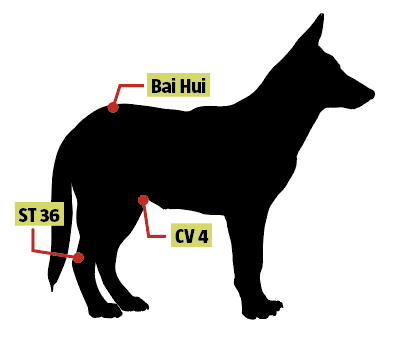
Our eight-year-old dog, Walter, has been diagnosed with Cushing’s disease. Our vet wants him to go on a drug called Vetoryl. Can you offer any holistic advice?
J.W., via email
Cushing’s disease is when the adrenal glands produce too much of the hormone cortisol. Also known as hyperadrenocorticism, or HAC, it’s a common condition in middle-aged or elderly dogs. However, many holistic vets, including myself, believe this syndrome is overdiagnosed, as some tests give too many false-positive results.
There are three types of canine Cushing’s disease:
Pituitary dependent. Enlargement of the pituitary gland due to a tumor causes it to secrete increased amounts of adrenocorticotropic hormone (ACTH), which stimulates the adrenal glands to secrete more and more cortisol. This is the most common cause, behind some 80–95 percent of Cushing’s cases. Poodles, especially miniature poodles, Dachshunds, Boxers, Boston terriers, Yorkshire terriers and Staffordshire terriers are most prone to this.
Adrenal dependent. This is also known as atypical Cushing’s and causes 15 percent of cases. In this type, there is a tumor on the adrenal gland itself. These tumors cause increased cortisol production and can be malignant (cancerous) about half the time. Large breeds and spayed females are more prone to this type.
Iatrogenic, which means a disease is caused by medical treatment itself. Iatrogenic Cushing’s is caused by steroid overuse and can affect any dog.
Holistic vets believe over-vaccination can dysregulate the immune system, which in turn can trigger tumor formation. Another potential cause is excessive radiation, which can affect hormone signaling, resulting in imbalance and tumors.
Symptoms of Cushing’s include drinking lots of water, excessive urination (more accidents in the house), ravenous appetite, panting incessantly, muscle wasting, a pot-bellied appearance (droopy stomach), thinning hair and skin darkening, hind leg weakness, obesity (with fat in the neck and shoulders) and tiredness.
The symptoms of Cushing’s are similar to diabetes and other conditions. A good vet will be able to differentiate and order the right tests to confirm Cushing’s. These include:
ACTH stimulation—the most popular test but not the most accurate. It misses 20–30 percent of dogs with a pituitary problem and 50 percent with an adrenal tumor.
High-dose dexamethasone suppression (HDDS), which can help differentiate between the adrenal and pituitary types of Cushing’s disease.
Low-dose dexamethasone suppression (LDDS)—by far the most accurate test, with only a 5–8 percent false-negative rate. But it takes eight hours and may cause significant stress to your dog. As a result, there is the possibility of your pet showing positive results because his adrenals are working overtime due to the stress of being without you.
I prefer testing the dog’s urine cortisol-creatinine ratio. This has 90 percent accuracy and causes the least stress to your dog. If this is elevated, the next step is an ultrasound of your dog’s abdomen to check for adrenal tumors.
If both adrenals are normal size and your dog has no symptoms of Cushing’s, then we can safely rule out Cushing’s, even if he has raised liver enzymes (a sign of Cushing’s) on his regular blood work. It is also important to test the specific gravity of your dog’s urine. If it is less than 1.025, Cushing’s is more likely.
The bottom line is to insist on a full workup before believing your dog has Cushing’s.
Depending on which form of Cushing’s your dog is diagnosed with, your vet will recommend surgery, radiation or drugs. Before deciding on one of these treatments, it’s useful to know the prognoses:
If your dog has a large pituitary tumor and also has neurological signs like seizures, stupor or anorexia, then radiation therapy may be an option and can be quite successful. However, most dogs will also need to stay on one of the drugs below.
Drug therapy is by far the most popular option and helps reduce cortisol levels or aims to destroy the tumors. In general, most dogs are placed on either mitotane (Lysodren), a chemotherapy drug used for pituitary and adrenal tumors, or trilostane (Vetoryl), used to treat pituitary-type Cushing’s. These, however, can cause side-effects.
Mitotane can cause vomiting, loss of appetite, depression and even seizures. And if there is an overdose, your dog can end up with Addison’s disease, the opposite syndrome where cortisol levels are too low.
Trilostane’s biggest issue is that it can cause adrenal necrosis—permanent destruction of adrenal function.
There are plenty of holistic options for dogs with Cushing’s, which can be used alongside conventional treatment, if necessary.
Diet
Feed your dog fresh, human-grade cooked or raw food with highly digestible protein (pasture-raised meats). It should be low in calcium to prevent the formation of bladder stones and low in fat to prevent pancreatitis and high cholesterol.
To satisfy your dog’s ravenous appetite, feed him plenty of fresh vegetables as fillers. See my book You Can Heal Your Pet for more information on the healthiest diet for Walter.
Traditional Chinese herbs
Traditional Chinese veterinary medicine (TCVM) can be a good option for dogs with Cushing’s. It’s essential to consult with a qualified TCVM vet who can prescribe the right remedies and dosages for your dog, but I have had good results with the following formulations:
Four Marvels (Si Miao San), from Kan Herbs, for pituitary Cushing’s.
Suggested dosage: follow the label/vet’s instructions
Relaxed Wanderer (Xiao Yao San), from Kan Herbs, for atypical Cushing’s.
Suggested dosage: follow the label/vet’s instructions
Ginkgo biloba is a useful herb for helping to reduce cortisol levels. If it’s not already part of a prescribed formula, it can be added separately.
Suggested dosage: 500 mg of powdered or capsule herb per 25–50 lb of body weight twice daily (every 12 hours) or 5–10 drops of tincture per 10 lb body weight twice daily. Avoid in dogs on anticoagulants or NSAIDs
Herbal combo supplements
There are several commercial herbal supplements that can be beneficial for dogs with Cushing’s by helping to support adrenal gland function. These include:
Adrenal Harmony Gold, by Pet Wellbeing, is a tincture containing ashwagandha, holy basil, milk thistle and other herbs
Adrenal Complex, by Standard Process, contains licorice and Rehmannia extracts
Guts and Glory, from Four Leaf Rover, features grass-fed organs and glands from New Zealand cows
Cushing’s Killer Combo, by PranaPets, is a bundle of three tinctures—C-support, CBD oil and Adrenal support—that can be used together
Daily defense, by Glacier Peak Holistics, is a powder formula containing dandelion and burdock.
Suggested dosages: for all products above, follow the label instructions
Other supplements
Lignans, a group of micronutrients found in plants, can be helpful for Cushing’s. Some vets recommend HMR (hydroxymatairesinol) lignans from the Norwegian spruce tree, while others recommend flaxseed lignans, which contain several types of lignans. All lignans can help reduce cortisol levels, but flaxseed lignans are higher in antioxidants and fiber.
Lignans For Life offers flaxseed lignans in capsule or bulk powder form.
Suggested dosage: for dogs under 25 lb, 10 mg daily; for medium to large dogs, 20–30 mg daily; for dogs over 100 lb, 40 mg daily
Melatonin works by regulating hormones and correcting circadian rhythms. It aids in improving coat quality in dogs with Cushing’s.
Suggested dosage: for dogs under 25 lb, 1.5 mg once or twice daily; for medium to large dogs, 3 mg once or twice daily; for dogs over 100 lb, 6 mg once or twice daily
Consult with a homeopathic vet to find the right formula and dosage for your dog, but here are the main remedies useful for Cushing’s.
Adrenalinum for maintaining adrenal balance
Arsenicum Album to alleviate excessive thirst, especially in dogs that also have diabetes, and to help with skin issues
Pituitarum Posterium, useful in pituitary-type Cushing’s
Sulfur may reduce frequent urination (especially with diabetic complications), skin and liver problems
Hepar Sulfuris Calcareum to help skin problems, abdominal swelling or bloating, and support the liver.

Acupressure can help regulate the hormone system and is something you can learn to do on your pet yourself. See my book You Can Heal Your Pet for a detailed guide to the technique. Here’s what to do for Cushing’s.
Apply gentle pressure with your thumb or forefinger for 30–60 seconds once daily on the following points:
ST36, ‘Stomach 36,’ is located behind or lateral to the tibial crest, on the outer side of the back leg, just below the knee in a depression where the lower leg (tibia) joins the knee. Stimulating this point can help ease stomach upset, improve appetite and relieve exhaustion.
CV4, ‘Conception vessel 4,’ is located on the abdomen about three inches behind the umbilicus—the dog’s belly button, just below the bottom of the rib cage. It helps with weakness and benefits the blood and chi deficiency.
Bai Hui, known as “The Point of 100 Meetings,” is located in the space between the lumbar and sacral vertebrae, at the level of the hip joints. It helps alleviate pain.
Dr Sathish is an award-winning holistic vet with 22 years of experience. After training in acupuncture, acupressure, energy healing, Emotional Freedom Technique (EFT), animal communication and herbal medicine, she now actively integrates conventional veterinary treatments with complementary therapies and is co-author of You Can Heal Your Pet (Hay House UK, 2015).
You can contact Dr Sathish at her website: www.rohinisholisticvetcare.com